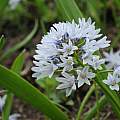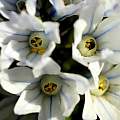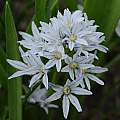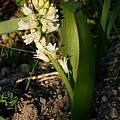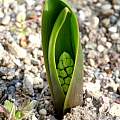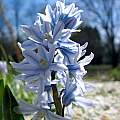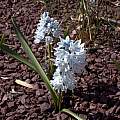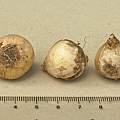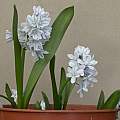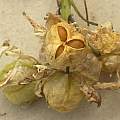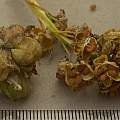Puschkinia is a small genus in the Hyacinthaceae family related to Scilla and Chionodoxa. Puschkinia is separate from Scilla by having petals fused at the base forming a short corolla. It is separated from Chionodoxa by having flattened filaments that are fused together forming a lobed corona, whereas in Chionodoxa the filaments are flattened yet independent. Here is a basic Dichotomous key to help distinguish between Chionodoxa, Puschkinia, and Scilla sensu stricto. It is named for the Russian botanist Apollo Mussin-Pushkin.
Puschkinia bilgineri Yıldırım is a newly described species native to Turkey. Height range: to about 38 cm. It was discovered by an amateur botanist and described by Turkish taxonomist Hasan Yildirim (epublished March 2014), who also took the following photos of plants in habitat.
Puschkinia peshmenii Rix & B.Mathew is a species from Turkey and Iran. It has greenish, somewhat pendent flowers that do not seem as open as the other species. Also, the flowers do not appear until the leaves are fully developed. This trait has been observed, both in the wild where the species distributions overlap and in cultivation where the species are grown together. Height range: 10-15 cm.
In a SRGC forum post from 2013, Jānis Rukšāns posted pictures of this species he had grown and photographed. See the post here.
Since then, a clonal, bright white form "Jim Archibald" has become commercially available, which is very similar to the second form Jānis Rukšāns describes, and not the greenish type. Photos show a plant cultivated by Martin Bohnet in southern Germany, where it flowers in April.
Puschkinia scilloides Adams (syn. Puschkinia libanotica) is native of alpine meadows in eastern Turkey, the Caucasus, Iran, and Lebanon. Growing to about 10-15 cm, it has bright pale blue flowers with a darker blue line along the center of each segment. Sometimes known as Puschkinia scilloides var. libanotica, 'Russian snowdrop', 'striped squill', or as the Latin name libanotica suggests 'Lebanon squill'. Puschkinia scilloides is the last of the "squills" to flower in Travis Owen's USDA zone 7 southern Oregon garden, often appearing after many of the Chionodoxa's and Scilla's have begun to set seed. Photos by John Lonsdale of two cultivars, 'Aragat's Gem', a form collected on Mount Aragats with bigger flowers that multiplies well, and 'Zangezur', a form collected in Azerbaijan with large flowers in a dense raceme.
Photo 1 below by Travis Owen shows the lobed corona, a feature unique to the genus.
Photos by David Pilling show commercial bulbs and the resulting flowers and seed; ruler marked in mm.
